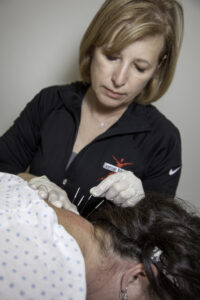Pain was Alyce Krouse’s constant companion.

Photo courtesy Stan O’Dell
Her physician diagnosed the pain in her hip and leg as a result of bulging disks and treated her with traction, nerve block injections and physical therapy. Nothing helped.
“I was not feeling any relief,” says Krouse, a pre-school teacher.
Then her physical therapist (PT), Kelly Shinall of Cornerstone Rehabilitation in Oxford, suggested an unusual new technique called functional dry needling, in which the PT inserts one or more small needles into the patient’s problem area.
“When people first hear of it, they think it must be like acupuncture,” says Shinall, one of only 48 PT’s certified in dry needling in Mississippi. “But the only thing it has in common with acupuncture is the use of a needle. It is based on medical scientific principles, not Eastern medicine.”
Dry needling treats pain and impaired movement by stimulating “underlying myofascial trigger points, muscular and connective tissues,” according to The American Physical Therapy Association.
Since Shinall was certified in November, she has successfully treated multiple patients. (See accompanying article for a personal story.)
“I’ve already seen some very promising, almost dramatic results, from patients on whom other therapies had not helped,” Shinall says. “It’s certainly not a miracle, but it can be a very helpful tool to add to existing physical therapy methods.”
Shinall learned the power of the technique herself during her first training seminar, when she developed a migraine headache. The workshop leaders administered dry needle therapy to her neck muscles.
“I’ve suffered from migraines for years and normally, they put me to bed for at least a day before I can function normally,” Shinall says. “But with the treatment, I was able to rejoin the training within a few hours.”
However, the therapy is not for everyone, including patients with certain health conditions or a metal allergy, Shinall cautions.
However, it has helped Krouse, who is still being treated.
“I have definitely seen results,” Krouse says. ”The pain and numbness have been significantly reduced.”
Physical therapists may evaluate and treat patients who have been diagnosed with a treatable condition in the last 180 day without a physician’s referral, according to the Mississippi Board of Physical Therapy website.
Some conditions or insurance companies may require a physician’s referral, though. Patients may take that referral to any physical therapist they choose.
For more information about functional dry needling or about Cornerstone Rehabilitation, call (662) 238-2800.
Robin Street is a lecturer at the Meek School of Journalism and New Media and can be reached at rbstreet@olemiss.edu.
